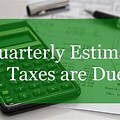
Employees have their taxes withheld by their employers. So, how do the self-employed pay? The self-employed pay estimated taxes quarterly by due dates to the IRS. This way, they can break their taxes into four instead of paying annually.
If you are a sole proprietor, self-employed, or own a small business, you will need to pay quarterly taxes to meet IRS deadlines. As long as you run your business on your own, you are a sole proprietor. Even if you're a contractor but run your business independently, you're a sole proprietor. Also, if you're a member of a partnership incorporated as an LLC, you may need to file quarterly taxes.
Although you're expected to file returns yearly, you are expected as a sole proprietor to make quarterly payments.
But it is not only sole proprietors that have to pay quarterly taxes. Because the IRS believes you should pay as you earn, you are due for quarterly payments if you (are projected to) owe above $1,000 when you subtract withholding and tax credits during tax filing of your return or you've made above $400 that year.
Corporations also have to pay estimated taxes as well.
Moreover, it is advisable to pay quarterly taxes to make the payment less cumbersome. Your bill can be paid more easily than waiting to pay in bulk.
How do I know my quarterly payments?
It is very straightforward to know your taxable income. First, not all your earnings as an entrepreneur are taxable. You need to know the deductions you're eligible for. These deductions are generally business expenses.
Once you've deducted the expenses from the income, the remainder is your taxable income. You may need advice from tax professionals to help you know how much you owe in taxes from the annual taxable income. A helpful guide is the IRS Form 1040 -ES. If you plan to itemize deductions, you should calculate the estimated total of your itemized deductions.
Remember that the income tax isn't the only obligation for sole proprietors and individuals who have to make quarterly filings. You also have to pay the self-employment tax, which stands at 15.3% (social security of 12.4, and Medicare of 2.9). If your annual income tops $142,800, the social security part stops, although Medicare continues.
If your taxable income falls below $164,900 for individuals and $329,800 for married couples filing jointly, you may be due for extra deductions, which will reduce your taxes by up to 20%
By now, you should know what you're due by year-end. So, divide it into four, and make quarterly payments before the due date!
How do I know the quarterly due dates?
Although the exact date varies slightly, the quarterly due dates are always in April, June, September, and January (of the following year).
The quarterly due dates for the 2022 tax year are April 18, June 15, September 15, and January 17, 2023. If you do not make payments before those dates, you are liable for a fine.
When it's time to pay, you can use the secure online tax payment system or pay by hand using the forms you were supplied by the IRS, that is, use the Mail-in vouchers on the Form 1040 SE.
If you're an independent contractor, each client that pays you above $600 that year should give you a Form 1099, which can also be used to compute your taxes. All the forms you got would help calculate your taxes.
What if I owe a balance by year-end?
Remember, you still have to make yearly filings. When you do, if you still owe any balance, that's when to settle your debt.
So, what happens if the projection falls short?
As is always the case, the projection often falls short or exceeds expectations. Once that happens, you should use Form 1040 -ES to make adjustments and pay the quarterly equivalent when due.
FOR MORE INFORMATION ON HOW JIM McCLAFLIN, EA, NTPI FELLOW, CTRC CAN BEST HELP YOU WITH YOUR TAX FILING NEEDS, PLEASE CLICK THE BLUE TAB ON THIS PAGE.
THANKS FOR VISITING.
Jim McClaflin, EA, NTPI Fellow, CTRC